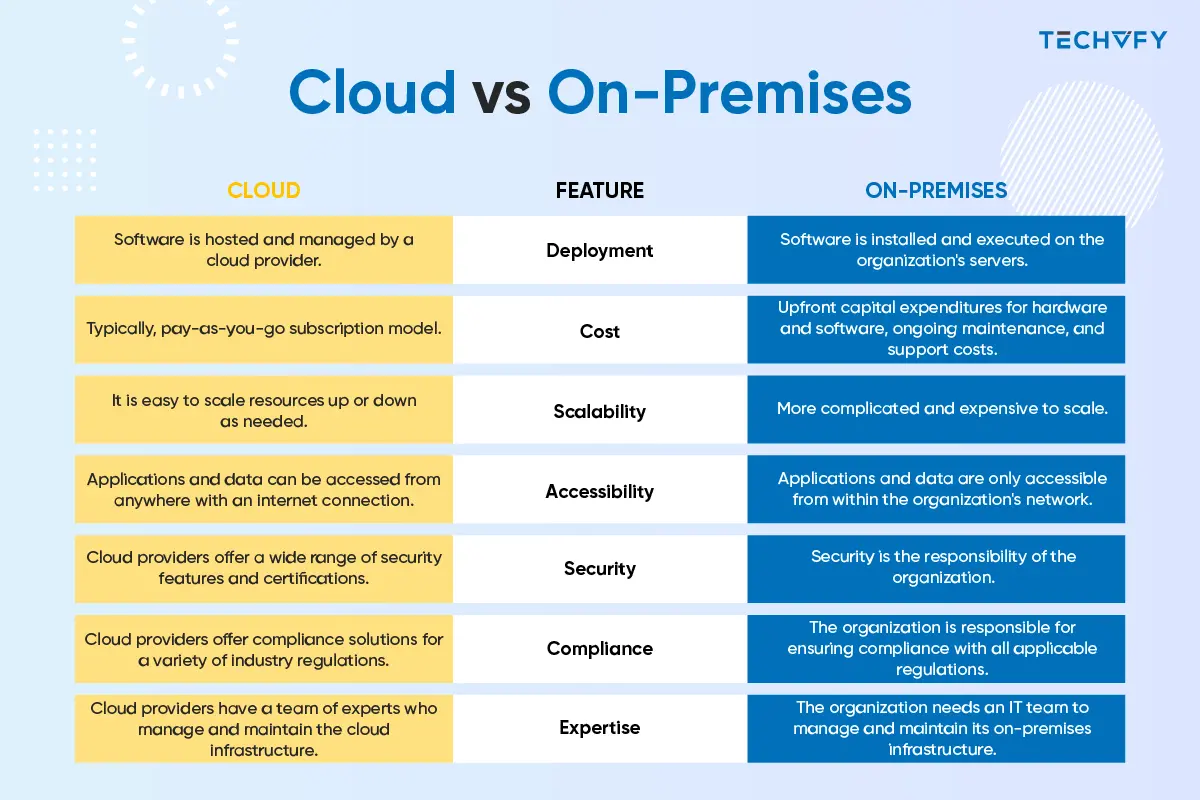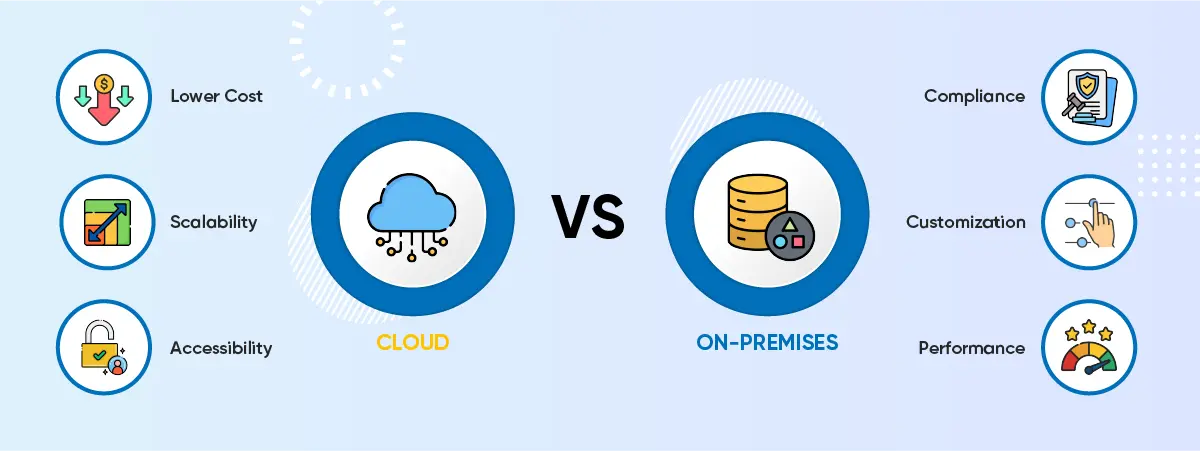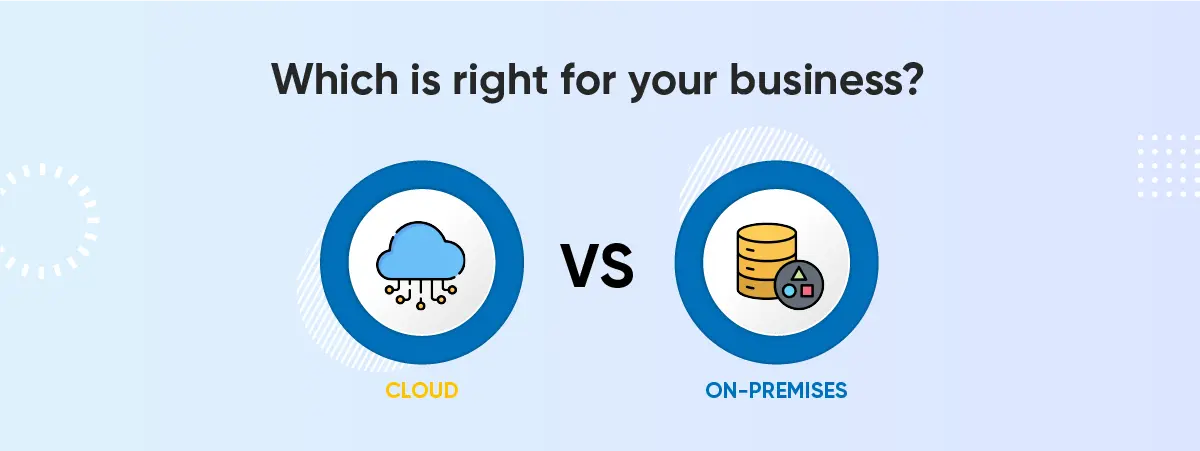In today’s rapidly evolving digital landscape, businesses face a critical decision regarding their IT infrastructure: on-premises or cloud computing. This choice represents a fundamental pivot point in how organizations manage their data, applications, and overall technology stack. This article discusses on-premises vs. cloud computing, comprehensively comparing features, benefits, drawbacks, and practical considerations.
I. What is On Premise vs Cloud?
What is On-Premises Computing?
On-premises computing is a traditional computing model in which an organization owns and operates its hardware and software infrastructure. This infrastructure is typically housed in a data center at the organization’s location.
What is Cloud Computing?
Cloud computing is a newer computing model in which an organization outsources its hardware and software infrastructure to a third-party provider. This provider hosts the infrastructure in a remote data center and makes it available to the organization over the Internet.
II. Cloud vs On Premises Comparison
This table answers the ” What is the difference between on premises and cloud” question.
Cloud vs On-premise Comparison Chart
Learn more on:
Best Cloud Storage for Business 2025
Top 10 IT Software Outsourcing Companies in Vietnam
III. On-premises vs Cloud Pros and Cons
The Benefits
- On-premises
Compliance: In-house computing can be more suitable for businesses that need to comply with strict industry regulations, as you have more control over your data and systems. For example, firms in the financial industry may be required to keep all data on-premises.
Customization: For businesses with unique requirements, this solution allows you to customize your hardware and software to meet your specific needs.
Performance: This computing can offer better performance for specific applications, such as those that require a lot of processing power or need to be accessed offline.
- Cloud
Lower Cost: This solution is typically less expensive than on-premises computing, as you only pay for the resources that you use. This upside can be a significant cost savings for businesses of all sizes.
Scalability: Cloud technology is highly scalable, so businesses can easily add or remove resources as needed.
Accessibility: Cloud-based applications and data can be accessed from anywhere with an internet connection, which can be helpful for businesses with remote employees or customers.
The Challenges
- On-premises
Cost: On-site computing can be more expensive than cloud computing, as you need to purchase and maintain your hardware and software. This feature can be a significant investment, especially for small businesses.
Complexity: Businesses need an IT team with the skills and knowledge to manage servers, networks, and security if they want to integrate in-house computing.
Scalability: When using on-premises computing and needing to add more resources, you must purchase and install new hardware and software. This trait can be time-consuming and expensive.
- Cloud
Security: While cloud providers offer a wide range of security features, it is essential to carefully review their security policies and procedures before moving your data to the cloud.
Vendor lock-in: Once you have moved your data and applications to the cloud, switching to another provider can be difficult and expensive.
Performance: Cloud computing performance can be affected by several factors, such as your network connection and the workload of other cloud users.
Looking to Outsource Development?
Contact TECHVIFY, Vietnam’s Leading Offshore Software Development & Outsourcing Company, for a consultation and development services.
IV. On-premises vs Cloud: Which is Right for Your Business?
The best way to decide whether cloud computing or on-premises computing suits business is to consider the specific needs and requirements. If your company is looking for a lower upfront cost, scalability, and accessibility, cloud computing is a good option. If you need to maintain strict control over your security and compliance or need to customize your hardware and software, then on-premises computing may be a better choice.
It is also important to consider budget and IT expertise when deciding. Cloud computing can be a perfect choice for businesses with a limited budget, as they only pay for the resources used. On-premises computing can be more expensive, but it may be a better option for businesses with a large IT team that can manage and maintain their infrastructure.
Conclusion
This article has discussed on-premises vs. cloud pros and cons. Cloud computing offers clear advantages in cost-effectiveness, scalability, accessibility, compliance support, and expert management. On the other hand, on-premises computing provides heightened control over data security, compliance, customization options, and potential performance benefits for specific use cases. Besides considering the benefits of cloud vs on-premises, it is also essential to consider your budget constraints and IT expertise to make the right choice.
Contact TECHVIFY if you need a consultation meeting to discuss your decision. We have experienced experts to help you leverage your resources effectively and affordably.
Let’s talk
A consultation with the Client Relationship Manager, who represents TECHVIFY, without any commitment from your side, will give you:
- Structured and clear vision of your future application
- Information about how our software development company guarantees 100% on-time and on-budget delivery
- Recommendations for choosing the tech stack
- Advice on further steps
- Business-side recommendations
- Rough project estimation on software development
TECHVIFY is right where you need. Contact us now for further consultation:
FAQs
What is The Difference Between on Premises and Cloud?
On-premises and cloud computing differ primarily in the location and management of their infrastructure. While cloud computing relies on third-party providers who host and operate the infrastructure remotely in data centers, on-premises computing entails running servers and software on-site within an organization’s data center.
Which is Better: Cloud or On-premises?
There is no one-size-fits-all answer. Your demands and preferences will determine whether you choose the cloud vs. on-premises. Cost-effectiveness and scalability exist in the cloud, although more security and customization options are available with on-premises solutions.
Can I Combine On-premises vs Cloud?
Yes, you can combine on-premises and cloud computing, which is known as a hybrid cloud approach. A hybrid cloud approach can give you the best of both worlds, allowing you to benefit from the cost-effectiveness and scalability of cloud computing while maintaining control over your sensitive data and systems.







